Discover the Cultural Depth of Bedouin Camps in Dubai
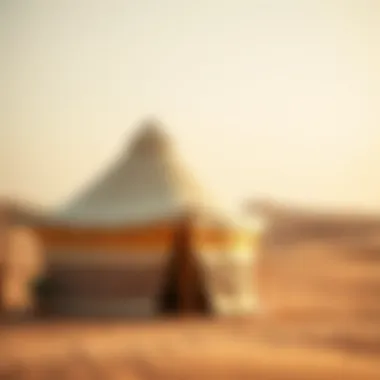
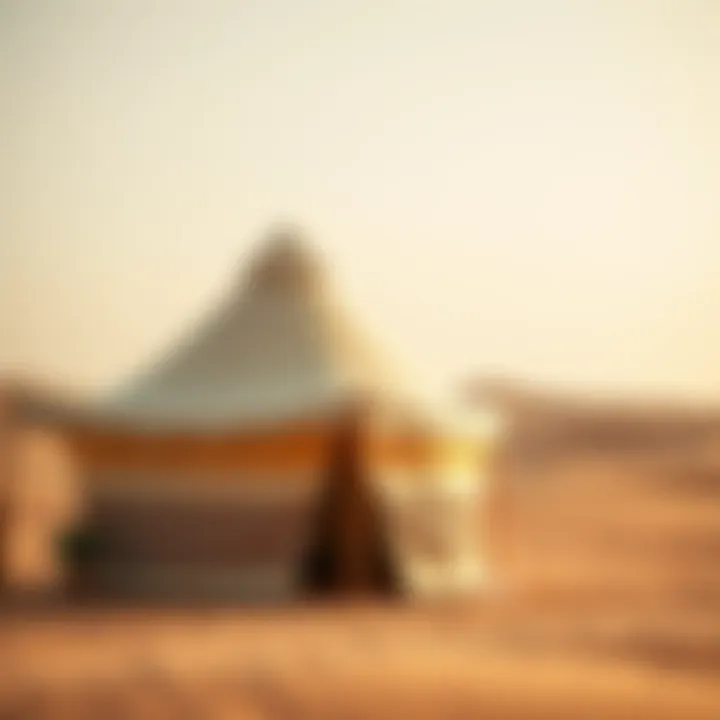
Intro
In the heart of Dubai's vibrant urban landscape lies an unexpected journey into the past—the Bedouin camps. These cultural havens provide a rich tapestry of experiences, illustrating the customs and traditions of a community nestled in the arid desert. From storytelling sessions under the stars to taste-testing authentic Bedouin cuisine, each moment at a camp is steeped in history, giving tourists and locals alike a rare glimpse into the nomadic lifestyle that has shaped this region.
Travelers looking to fully immerse themselves in Dubai's cultural offerings will find that Bedouin camps are more than just tourist traps; they serve as a vital link between ancient heritage and modern life. The essence of the Bedouin spirit remains alive in these settings, where hospitality reigns supreme, and every guest is treated as family.
In exploring Bedouin camps, one could surely discover the delicate balance between the past and present. This article aims to uncover the numerous facets of these camps, including their historical significance, the variety of experiences they offer, and their emerging role in tourism within Dubai.
As we embark on this exploration, prepare to delve deep into a world that, while appearing distant from the glimmering skyscrapers of the city, continues to ebbs and flows with the rhythm of a time-worn lifestyle.
Prelude to Bedouin Culture
Understanding Bedouin culture is pivotal for anyone looking to immerse themselves in the rich tapestry of Dubai's heritage. This culture not only shapes the social landscape of the region but also intertwines with the modern identity of the city. As Dubai embraces rapid development and cosmopolitan lifestyles, the Bedouin narrative remains a touchstone for authenticity and tradition amidst this dynamic evolution.
Historical Background
The Bedouins are a group of nomadic peoples primarily found in the deserts of the Arabian Peninsula. Their history stretches vividly across millennia, deeply rooted in survival and adaptation to the arid climate. Initially, these tribes roamed the sands, living off livestock such as camels, goats, and sheep, which were essential to their nomadic lifestyle. Tales of fierce battles and alliances amongst tribes pepper their lore, reflecting a culture forged in resilience and determination.
The traditional oral storytelling has passed down invaluable lessons and wisdom, providing glimpses into their history and values. Over time, many Bedouins settled and integrated with urban societies, especially with the advent of oil wealth in the mid-20th century. This settlement sparked a blend of old and new, allowing Bedouin heritage to flourish while adapting to contemporary life. The cultural richness of the Bedouins now stands as a pillar of Dubai’s identity, enriching the visitor experience.
The Bedouin Lifestyle
At its core, the Bedouin lifestyle is an intricate interplay of simplicity and ingenuity. Life in the desert is dictated by natural rhythms and seasons – the harsh summers and mild winters mold the daily activities of the Bedouin people. They traditionally emphasize hospitality, seeing it as a vital trait, often entertaining guests with coffee and dates.
The tents they use, known as bayt al-sha'ar, are crafted from goat’s hair, showcasing their resourcefulness and skill. A Bedouin’s wealth is typically measured by the number of camels they own, symbolizing both livelihood and prestige. The core values of community, family loyalty, and respect for nature permeate through their way of life.
For the modern observer in Dubai, these aspects manifest in Bedouin camps that recreate the intricacies of their lifestyle, offering insights into their age-old practices and traditions. The connection between the land and its people remains palpable here, urging visitors to appreciate the deeper meanings behind each ritual and custom.
"To understand a people, one must walk in their desert" - this timeless saying underlines the essence of Bedouin culture, inviting all who are curious to explore its depths.
Overview of Bedouin Camps in Dubai
Bedouin camps in Dubai offer travelers and locals a window into the rich tapestry of Arab culture. These camps not only serve as a retreat from the hustle of city life but also create a bridge between the past and the present. They provide an immersive experience that showcases the vibrant traditions, customs, and lifestyles of the Bedouin people. Understanding the significance of these camps helps one appreciate the depth of cultural heritage that Dubai has to offer.
Purpose and Purpose
The purpose of Bedouin camps goes beyond mere entertainment. They are a vital platform for cultural exchange and education. By visiting these camps, individuals can experience the authentic practices of the Bedouin lifestyle, which emphasizes community, hospitality, and resilience in the face of challenging desert conditions. For tourists, it is an opportunity to witness firsthand how traditional Bedouin life exists alongside modernity, showcasing a harmonious balance of old and new.
Moreover, the camps provide an economic boost to the local community. Many families depend on the income generated from hosting tourists. This supports not just the camps, but also wider local businesses like artisans, bakers, and other service providers. In this light, visiting a Bedouin camp is more than just a leisure activity; it’s a way to engage with and support local culture and economy.
Location and Accessibility
Most Bedouin camps are strategically placed on the outskirts of the city, tucked away in the desert landscape. This not only offers a serene backdrop but also enhances the authenticity of the experience. The camps are typically located within a reasonable distance from the central tourist areas in Dubai, making them accessible for those looking to escape the concrete jungle without straying too far.
To reach these camps, several options are available:
- Guided Tours: Many tour operators offer packages featuring transportation, activities, and dining experiences.
- Self-Drive: Adventurous visitors may choose to rent a vehicle, taking advantage of road signs leading to various camps.
- Ride-sharing Services: Apps like Uber and Careem have expanded, making rides to these camps feasible.
Typically, accessing these camps can be done within 30 to 45 minutes from central Dubai, depending on traffic and chosen attractions along the way. This easy accessibility highlights the camps’ role as a key component of the tourist experience in Dubai, enabling individuals to appreciate both the beauty of the desert and the traditions of its inhabitants.
Cultural Experiences Offered
Cultural experiences at Bedouin camps play a pivotal role in grasping the essence of Dubai’s rich heritage. When visitors step into these camps, they're not just entering another tourist attraction; they are immersing themselves into a world that reflects the values, traditions, and influences that have shaped the region for centuries. The offerings here engage with the senses—sight, sound, taste, and touch—allowing guests to form a deeper connection with the Bedouin culture.
Traditional Cuisine
Exploring the culinary delights within Bedouin camps provides an authentic taste of the traditions of the region. The meals served here often showcase local ingredients, many of which have been staples in Bedouin diets for generations. Visitors can expect dishes such as shawarma, grilled meats, and delicious bread baked over an open fire.
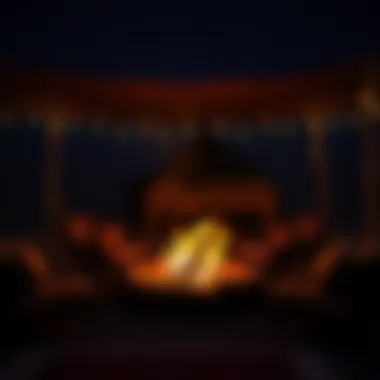

Notably, the preparation and serving of these meals can be as significant as the food itself. Traditional dining often features communal meals, where guests sit together, sharing not just food but also stories, laughter, and life experiences. This fosters a sense of community and belonging, mirroring the Bedouin way of living where hospitality is a cherished virtue.
Crafts and Artistry
Artisanal crafts reflect the creativity and skills honed through time in Bedouin society. Within the camps, visitors encounter artisans who specialize in weaving, pottery, and intricate beadwork. Each piece tells a story—whether it's a rug that has patterns representing local landscape or pottery distinct to various tribes.
Guests can even participate in hands-on workshops, engaging in these crafts. This not just promotes cultural appreciation but also helps preserve these skills that could easily be lost in an increasingly digital world. Beyond making souvenirs, these activities provide a tangible connection to Bedouin history.
Music and Dance
Music and dance form the heartbeat of any gathering, and at Bedouin camps, this is no different. Visitors are treated to traditional performances that may include Al Ayalah, a folk dance depicting shared history and camaraderie. The rhythmic beats of the drums resonate through the desert, creating an environment alive with culture.
The spirit of these performances isn’t merely for entertainment; it’s a means of storytelling that informs the uninitiated about Bedouin folklore and values. Participants can even join in, creating a unique fusion of cultures as travelers step gracefully into the circle, celebrating life through movement.
The intertwining of cuisine, craftsmanship, and performance creates a rich tapestry that defines the Bedouin experience. Each facet invites visitors to appreciate not just the culture but also the resilient spirit behind it.
Through these carefully curated cultural experiences, Bedouin camps in Dubai facilitate a bridge between the ancient and contemporary, making a visit here a significant and transformative journey.
Activities at Bedouin Camps
Bedouin camps in Dubai offer a treasure trove of activities that dive into the essence of Emirati culture and harness the unique features of the desert environment. These activities not only add an adventure aspect for visitors but also allow a deeper understanding of the traditional Bedouin way of life. Emphasizing both fun and cultural education, these encounters enrich the experience for tourists and locals alike by providing a firsthand look at customs, skills, and recreational fun.
Camel Rides
Camel riding ranks high on the list of must-do activities in Bedouin camps. Known as the "ships of the desert," camels have been an integral part of Bedouin culture for centuries. A journey on one of these gentle giants offers more than just a quirky photo op; it gives a taste of how Bedouins once traversed the arid landscape.
The experience typically starts with a warm welcome from the camel handlers, who have developed a bond with these animals over many years. As riders mount their camels, they might feel a bit awkward at first, swaying as the camel rises. But after a little getting used to, riders find the rhythm.
"Camel rides provide an enchanting glimpse into the traditions of desert life and foster an appreciation for the artistry behind the Arab way of communication with these creatures."
This activity is suitable for people of all ages, creating good memories and encouraging conversations around the significance of camels in Emirati history and hospitality.
Dune Bashing
For thrill-seekers, dune bashing is nothing short of exhilarating. This off-road adventure takes visitors over the rolling dunes in a 4x4 vehicle, with professional drivers at the helm. Expect the unexpected as you navigate steep slopes and gliding descents, an experience that mixes excitement with the awe of the desert landscape.
As the vehicle climbs and drops, riders often feel a mixture of fear and excitement—a GPS-guided rollercoaster ride through golden sand. It’s also a fantastic opportunity to capture photos of the stunning scenery, where the interplay of light and shadow creates a dynamic visual treat.
The introduction of dune bashing into the Bedouin camp experience reflects the blending of modern adventure with traditional lifestyles, showcasing how Bedouins have adapted to contemporary tourism while still honoring their roots.
Sandboarding
If riding camels or dune bashing isn’t quite your style, sandboarding may offer the fill of adrenaline you seek. Similar to snowboarding, this activity allows participants to ride down dunes, carving their path in the sandy slopes. Although it requires a bit more balance than its snow-covered cousin, it’s usually an exhilarating experience, especially for the younger crowd.
Many camps provide boards and brief instructions for beginners. The initial awkwardness slowly vanishes once you find your footing—suddenly it feels like soaring down a surf unto the briny expanse. Each ride could provide a different experience, depending on the shifting sands beneath.
Ultimately, sandboarding embodies the spirit of adventure and exploration. It connects individuals with both nature and the landscape while reinforcing the idea that there are layers of experiences to be had in the desert beyond just cultural appreciation.
Accommodations in Bedouin Camps
When we think about immersing ourselves in Bedouin culture, one cannot overlook the significance of accommodations offered at these camps. A stay in a Bedouin camp isn’t merely about sleeping under a desert sky; it’s an introduction to a lifestyle steeped in traditions and values. The type of accommodations available has become a pivotal element in how visitors experience this rich culture and impacts their entire stay.
Tents and Facilities
The tents at Bedouin camps, traditionally made of goat hair, provide a unique and authentic experience that connects guests to the Bedouin way of life. Built to withstand the harsh climate of the desert, these tents are not just functional; they are a symbol of centuries-old practices. Pricing for these accommodations tends to vary, influenced by factors such as proximity to major attractions and the amenities included.
Modern facilities have blended seamlessly with these tents, offering necessary comforts without losing the essence of authenticity. Many camps have upgraded their offerings, ensuring features like:
- Air conditioning: Something essential in the Dubai heat.
- Private restrooms: To maintain a level of comfort expected by today’s travelers.
- Sleeping arrangements: Whether it’s plush mattresses or traditional bedding, they cater to varied preferences.
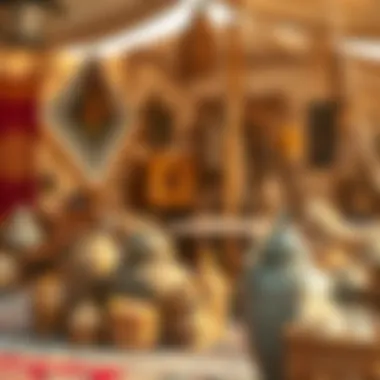
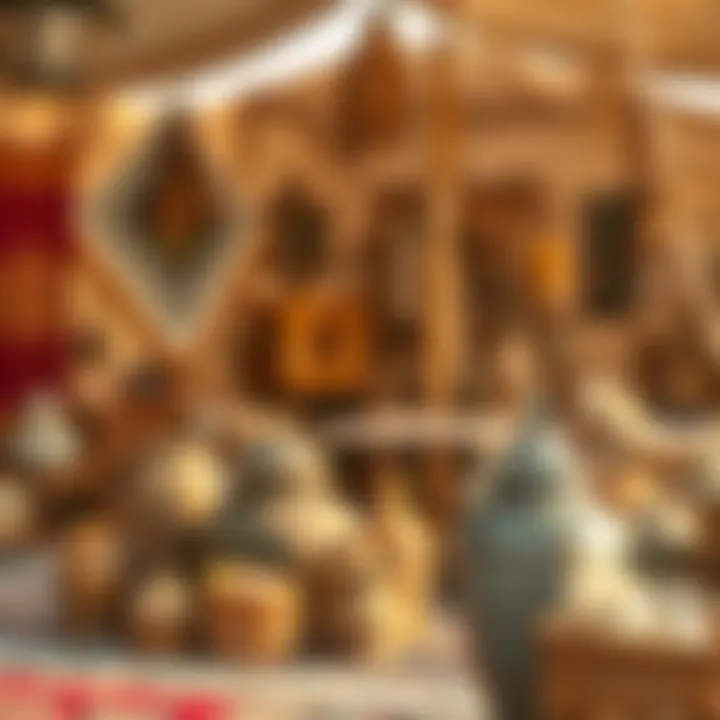
These advancements not only meet the demands of today's guests but also open a window into the Bedouin ambiance, where luxury and tradition coexist.
Comfort Levels
Comfort levels at Bedouin camps can run the spectrum, accommodating various preferences and budgets. Some camps offer a simplistic experience that emphasizes a connection to nature while others have luxurious options with all the frills.
For instance, guests on a tighter budget might find that some camps offer shared facilities but still provide a warm, communal atmosphere that fosters interaction among visitors. On the other hand, high-end camps may offer lavish suites with opulent furnishings, en-suite bathrooms, and personalized services. Travelers might appreciate:
- Luxury tents with private plunge pools.
- Common areas that encourage storytelling and cultural sharing.
- Themed nights featuring traditional food and entertainment.
Ultimately, the comfort level chosen by visitors often mirrors their desire for either a roughing-it experience under the stars or a more refined stay that blends heritage with modern sensibilities.
In essence, the variety in accommodations reflects the broader spectrum of Bedouin culture – a fusion of identity and adaptability to meet modern expectations while honoring age-old traditions.
By prioritizing what guests value in their stay, these camps position themselves not only as places to rest but as immersive experiences designed to resonate with the diverse backgrounds of their visitors. Learning about and experiencing the tents and facilities in Bedouin camps allows for a deeper understanding of a culture that has thrived against the backdrop of the dramatic desert landscape.
Tourism Impact on Bedouin Camps
Tourism plays a vital role in the sustenance and development of Bedouin camps in Dubai. These camps not only serve as a window into the rich cultural history of the Bedouin people, but they also contribute significantly to the local economy and the preservation of traditions. Understanding the impact of tourism in this context is like peeking behind the curtain of a vibrant tapestry woven from ancient threads and modern aspirations.
Economic Contributions
The financial benefits of tourism for Bedouin camps are substantial. Visitors flock from all corners of the globe, eager to experience the authentic lifestyle that the camps offer. This influx of tourists brings with it a variety of revenue streams. Camp owners often rely on the profits from camel rides, traditional meals, and cultural performances. Each visitor who pays for a night under the stars supports not just the camp itself but also the numerous local vendors and artisans who provide handicrafts and traditional goods.
- Job Creation: The demand for services in these camps leads to a boost in employment opportunities for local residents. This includes camp managers, chefs, guides, and artisans.
- Investment Opportunities: The growing interest in cultural tourism attracts investors looking to expand their portfolios into unique guest experiences. This growth can enhance the facilities provided in the camps and thus improve visitor experiences altogether.
- Supporting Local Businesses: The camps often collaborate with local businesses for food supplies, crafts, and decor, thus creating a symbiotic relationship with the surrounding community.
A case in point is the use of local ingredients in traditional meals offered at the camps. This commitment to source locally not only freshens dishes but also supports farmers and markets within the region.
Cultural Preservation
The impact of tourism on cultural preservation in Bedouin camps cannot be overstated. As modernity seeps into every corner of society, these camps remain bastions of traditional practices. Visitors contribute to cultural preservation in several key ways:
- Revitalizing Traditions: Many camps vigorously showcase traditional Bedouin customs, such as poetry reading, storytelling, and traditional music. These are more than just performances; they serve as cultural transmission vehicles, keeping age-old stories alive.
- Educational Experiences: Tours often include educational components where visitors learn about the Bedouin way of life, including traditional skills like weaving and cooking. Increased awareness fosters respect and appreciation for these cultures.
- Encouraging Community Participation: The interest from tourists encourages the community to engage in their cultural practices more frequently. The pride in their heritage becomes revitalized when they showcase it to eager audiences.
"The greatest legacy we can pass to our children is not the riches, but the treasures of our culture and history," a camp elder once shared, echoing the sentiments of many within the community.
In summary, tourism serves as a lifeline for Bedouin camps in Dubai. The economic influx provides a foundation that supports not only the camps but the broader community as well. Simultaneously, it acts as a custodian of tradition, ensuring the Bedouin way of life continues to thrive in a rapidly changing world.
Sustainability Practices
Sustainability practices are becoming increasingly vital in discussions surrounding tourism, especially in culturally rich areas like the Bedouin camps of Dubai. With a growing emphasis on minimizing environmental footprints while fostering a respectful relationship with the local culture, these practices offer a pathway to preserve the unique essence of Bedouin life for future generations. Not only do sustainability efforts protect the natural surroundings, but they also serve as a crucial link between local heritage and modern tourism.
Environmental Considerations
In the context of Bedouin camps, environmental considerations play a pivotal role in maintaining the delicate balance between tourism and ecology. The desert habitat is inherently fragile; thus, the camps must implement various strategies to protect it. For instance, many camps are now harnessing renewable energy sources such as solar power.
- Water Conservation: Water resources are scarce in the desert. Implementing systems that recycle water or using biodegradable products helps conserve this precious resource.
- Waste Management: Camps are increasingly adopting waste segregation practices. This not only reduces litter but also facilitates recycling and composting, which contributes to environmental sustainability.
- Natural Materials: The construction and decor of the camps often utilize materials that blend well with the surroundings. This minimizes disruption to the local environment and enhances the authentic experience.
These efforts do not go unnoticed. Tourists are drawn to camps that actively engage in protecting their natural surroundings. This enhances their overall experience, making them feel part of something larger than themselves.
"Sustainability in tourism is not just a choice; it's a responsibility we owe to the earth and its inhabitants."
Community Involvement
Equally important to sustainability practices within Bedouin camps is the involvement of the local community. The authentic experiences offered in these camps stem from cultural heritage, and integrating the community’s voice into tourism allows for a richer interaction and learning opportunity for visitors.
- Job Creation: Local individuals often find employment within the camps, whether as guides, cooks, or artisans. This helps the local economy and preserves traditional livelihoods.
- Cultural Education: Workshops led by local artisans offer tourists firsthand insights into Bedouin traditions, crafts, and music. This not only enriches the visitor's experience but also empowers local communities by showcasing their skills.
- Feedback and Adaptation: Involving the community in decision-making ensures that their interests and cultural values are represented. It helps the camps adapt to changing visitor expectations while still honoring the deeply rooted traditions of the Bedouins.
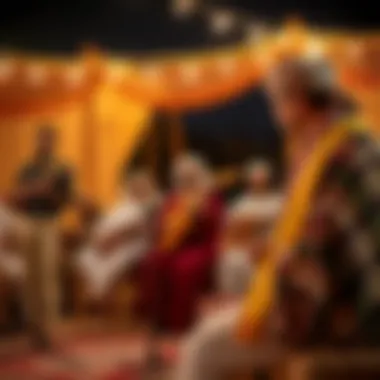
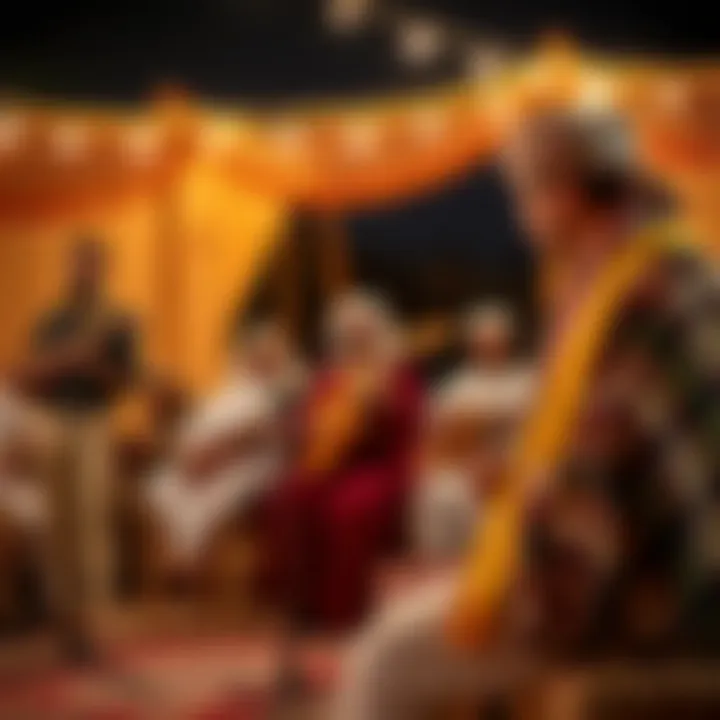
Sustainability practices and community involvement are interacting elements that enhance the Bedouin camp experience. Together, they foster a respectful coexistence of tourism and tradition, allowing visitors to engage with the rich cultural tapestry of the Bedouin lifestyle without compromising its integrity.
Challenges Facing Bedouin Camps
The allure of Bedouin camps in Dubai often overshadows the challenges they face today. These camps, which offer a slice of traditional lifestyle amid the bustling modernity of Dubai, are constantly striving to preserve their identity while accommodating the evolving demands of tourism.
It's essential to talk about the complexities involved in running these camps, as they serve not only as tourist destinations but also as cultural heritage sites. The balance between showcasing their rich traditions and adapting to contemporary visitor expectations represents a vital conversation in this narrative.
Balancing Tradition and Modernity
The challenge of adapting to modern trends while keeping their rich cultural heritage intact is something Bedouin camps grapple with daily. As tourists come seeking an authentic experience, the camps must meet those expectations without losing their traditional essence. This balancing act can be quite tricky; if they lean too heavily into modern amenities and comforts, they risk alienating visitors who desire a genuine cultural immersion.
Key considerations include:
- Preserving traditional crafts and practices such as weaving and pottery, which are often overshadowed by contemporary entertainment options.
- Ensuring that the storytelling of their history and the significance of their customs remains palpable in the experiences offered.
- Creating an atmosphere where visitors can engage with locals, thereby fostering an understanding of the Bedouin way of life.
Despite the pressures, some camps have found innovative ways to modernize without losing their core identity. "Gazing at the stars as you listen to tales of the desert—now that’s timeless." This quote encapsulates the idea that authenticity lies in the storytelling and connection to the land, rooted in moments that cannot be manufactured by modern means alone.
Competition with Other Attractions
Another pressing challenge for Bedouin camps is the competition posed by Dubai's other world-renowned attractions. With the skyscrapers, shopping malls, and beach resorts drawing tourists, Bedouin camps must carve out a unique space for themselves. To stay relevant, they need to highlight not only what makes them distinct but also how they provide a versatile experience blending culture, education, and fun.
Strategies being employed include:
- Collaborative packages with other attractions, such as combining a desert safari with a visit to the Dubai Aquarium or the Burj Khalifa.
- Enhanced marketing tactics that emphasize specialty events, such as cultural festivals centered around food and music, attracting those looking for unique experiences.
- Targeting niche audiences who might be more inclined to appreciate cultural tourism, like art enthusiasts and culinary explorers.
"For every attraction vying for attention, the Bedouin spirit offers a glimpse into a world that once was, letting us taste the past straight from the source."
Future of Bedouin Camps in Dubai
The Bedouin camps in Dubai stand at a crossroads of rich cultural tradition and modernity. Their future is pivotal not just for those who cherish the age-old customs of the Bedouin people, but also for the growing tourism sector that thrives on authentic cultural experiences. As Dubai continues to evolve as a global tourism hub, the nuanced balance between tradition and innovation will shape the trajectory of these camps.
Adapting to Changing Trends
The landscape of tourism is constantly in flux, influenced by a multitude of factors ranging from global economic conditions to shifts in consumer preferences. The Bedouin camps must adapt to these changes to remain relevant.
- Experiential Travel: Visitors today seek more than just picturesque views; they want immersive experiences. Camps can enhance their offerings by including hands-on activities in traditional crafts, such as weaving or pottery.
- Sustainability Efforts: With increasing awareness of environmental issues, there's a growing preference for eco-friendly tourism. Utilizing solar power and reducing waste can not only attract eco-conscious tourists but also preserve the delicate desert ecosystem.
- Luxury Encounters: As the market for luxury travel expands, integrating opulent amenities without compromising the cultural experience can be a winning strategy. This could include luxurious tent accommodations that feature modern comforts, while still reflecting Bedouin aesthetics.
Adapting to changing trends does not mean losing the core identity of what makes these camps unique. The challenge lies in merging authenticity with modern expectations, giving visitors memorable experiences that resonate long after their stay.
Evolving Visitor Expectations
Today's travelers are savvy and discerning, often equipped with extensive research before arriving at their destinations. Understanding and meeting these evolving expectations is crucial for the survival of Bedouin camps.
- Authenticity Over Simplicity: Modern tourists value authenticity. They want to partake in genuine cultural experiences that provide insight into the Bedouin way of life. Camps should focus on storytelling and incorporating local voices in their activities.
- Personalized Services: Visitors are looking for tailored experiences that cater specifically to their interests, whether that is culinary experiences, adventure activities or cultural seminars. This may require hiring staff with diverse backgrounds who can provide varied insights into the local culture.
- Digital Integration: With the age of technology, a seamless digital experience is valued. From booking apps to virtual guides, embracing technology can enhance the visitor experience while providing convenience.
Bedouin camps must evolve to maintain their charm amidst changing societal preferences. By balancing tradition with modern demands, these camps can carve out a sustainable future that honors their heritage while appealing to a new generation of travelers.
"The key to the future of Bedouin camps lies in their ability to gracefully merge tradition with innovation, offering travelers an intimate glimpse into a culture rich with stories and experiences."
Culmination
In the tapestry of Dubai's rich cultural and historical fabric, Bedouin camps stand out as a testament to resilience and tradition. These camps do not merely serve as tourist attractions, but rather as living embodiments of a way of life that has traversed centuries, weathering the storms of modernization. By reflecting on their cultural significance, we understand how they encapsulate the spirit of the Emirati heritage.
Reflection on Cultural Significance
Bedouin culture is woven deeply into the identity of the UAE. The traditions, storytelling, and customs observed in these camps open a window into a world that many may not have the chance to see otherwise. Each camp serves as a repository of knowledge, preserving the unique dialects and folklore that have been passed down through generations. Visitors not only gain insights into traditional lifestyles but also participate in a shared experience that honors the past. This connection to historical roots is paramount, allowing both residents and tourists to appreciate the duality of tradition meeting modernity. The lasting memories forged in these settings carry a weight that enriches the human experience beyond mere sightseeing.
Encouragement to Experience the Camps
Visiting a Bedouin camp is an invitation to partake in a transformative experience. As one steps into these oases of culture, they become instant witnesses to the artistry of handmade crafts and the savory delights of traditional dishes. Engaging with local artisans or joining in the rhythmic pulse of traditional music and dance provides an uncommon depth to the understanding of Emirati life.
While the bustling city of Dubai dazzles with its skyscrapers, the Bedouin camps offer a contrasting landscape rooted in serenity and authenticity. For anyone with a thirst for knowledge and adventure, the call to explore these cultural havens cannot be ignored. Be it through the gentle sway of a camel ride or the camaraderie shared over a meal cooked with heart, these camps beckon all to discover the soul of the desert.
In a nutshell, experiencing a Bedouin camp is more than just a stopover in an itinerary; it’s a step into a captivating narrative, where every corner whispers stories of endurance and hospitality. Whether you're an investor looking to create a fusion of modern and traditional experiences, or simply a traveler seeking the richness of a vivid culture, the essence of Bedouin life in Dubai awaits to show you what it means to be part of something timeless.















